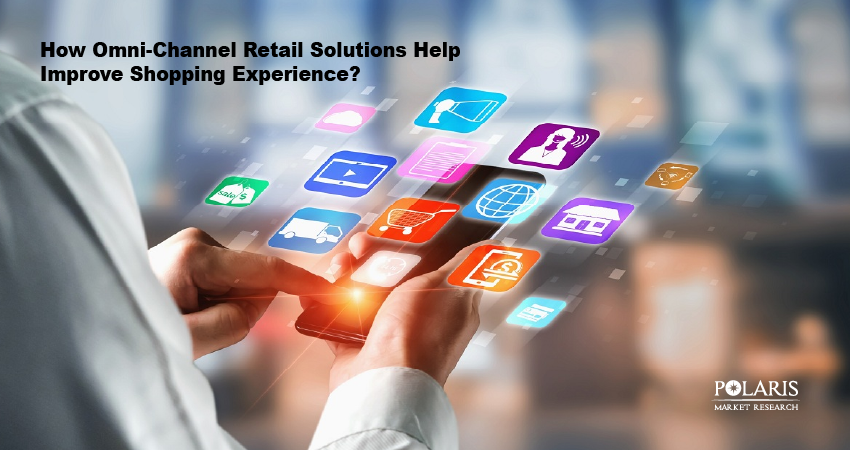How Omni-Channel Retail Solutions Help Improve Shopping Experience?

The world of retail and e-commerce is always evolving. New trends continue to define how consumers look for products and make purchases. Flexibility and convenience have now taken the stage in retail shopping. And omni-channel retaining takes these concepts to new levels.
But what exactly is omni-channel retailing? And what unique benefits does it have to offer? This blog post explains all that you need to know about omni-channel retailing. Additionally, the role of artificial intelligence in driving the omni-channel retail solutions market has also been covered. Read on!
What Is Omni-Channel Retail?
Omni-channel is a term used to describe a model that allows users to interact with several physical and e-commerce market sales channels at the same time. Here, the information is retained by the retailer as consumers move from one channel to another. Omni-channel retailing allows for asynchronous shopping. Customers have the option to proceed with their transaction from the point they last left. In essence, omni-channel retailing makes for a consistent shopping experience that spans every customer touchpoint.
With omni-channel retailing, it’s possible for customers to browse on a laptop, use their smartphone to compare prices, and then visit a physical store to make the purchase. All without having to go through the process all over again. This linking of channels makes for a highly unified experience.
How Omni-Channel Works?
There isn’t a specific answer to how omni-channel works. There are several ways in which the implementation of the omni-channel strategy can be done. That said, there are some basic principles that apply to all implementations.
First, companies need to have a strong understanding of the needs and behaviors of their customers. The presence of technology that supports multiple channels is needed. Businesses must also be able to track data across these channels.
Second, businesses must have the resources for managing every aspect of an omnichannel strategy. This means having a team that ensures efforts are coordinated across channels and everyone stays updated on the latest things.
Companies also need to be prepared for the constant evolution of the omni-channel strategy. The needs and behaviors of customers keep changing. So, businesses must be able to adapt to them. That translates to experimenting with new things and being open to new ideas.
What Is the Omni-Channel Retail Solutions Market Outlook?
We’ve done a detailed analysis of the omni-channel retail solutions market. Our analysis reveals that the market for omni-channel retail solutions stood at USD 8.28 billion in 2024. It is expected to account for a CAGR of 12.03% from 2025 to 2034.
The growing demand for centralized data points and various benefits offered by omni-channel analytics are driving the adoption of these solutions. Rising consumer preference for online shopping is also having a favorable impact on the omni-channel retail solutions market expansion.
How Is Omni-Channel Different?
There are several approaches to retail. The three main ones include single-channel, multi-channel, and omni-channel. Understanding the differences between these channels is important for businesses.
The single-channel approach involves the business going with a single channel. The channel may be a physical facility or an online store. Similarly, a multi-channel approach means a business uses multiple channels without coordinated efforts. Think of it as a business that operates both online and in a physical store. However, there’s no coordination between these channels.
An omni-channel approach differs from the single-channel and multi-channel approaches. It ensures that there’s coordination between these channels so that they work seamlessly. The omni-channel approach aims to provide a consistent experience for customers no matter which channel they opt for to interact with the brand.
What Are the Benefits of Omni-Channel Retail?
Utilizing omnichannel retail solutions can help businesses enhance the customer experience and engagement. The various benefits of omni-channel retail are given below:
Improved Customer Experience
Businesses can improve their customer experience with omni-channel retail. This, in turn, can increase their customer satisfaction score (CSAT). As a refresher, CSAT is a metric used to measure customer loyalty and satisfaction with a company's products or services. Omnichannel retail solutions place the customer first and allow them to easily interact with the business using their preferred channel. It also brings all customer information in one place.
Added Inventory Visibility
Another benefit of omni-channel retail is added inventory visibility. It helps companies get products to places where they should be. Without the assistance of suppliers, vendors, and distributors, products would not get the visibility they need. The analytics and unified platform offered by omni-channel retail solutions make it easier for businesses to manage their inventory. Improved visibility can also create cross-sell and upsell opportunities for agents.
Meet Customers Where They Are
Flexible shopping is what modern consumers desire. Omni-channel retail enables companies to meet customers where they are and provide the experience they seek. Providing flexible shipping can take the form of having several shipping and delivery options. The options for online and in-store buying are also a part of flexible shopping.
How AI Is Changing Omni-channel Retail Solutions?
AI has the capability to analyze the behavior of customers across multiple channels. This data can be used by businesses to provide experiences that are highly personalized. Customer service is also improved using AI-chabots as they can offer instant customer support. Solutions from the smart retail market can predict demand and ensure the availability of right products across all the sales channels of the business. The ability of AI to segment customers and automate campaigns helps improve the marketing efforts of the company.
Conclusion
Omni-channel retail solutions enable retailers to have higher availability. These solutions also allow them to drive traffic and increase sales. With an omni-channel strategy in place, customers have more channels for making purchases using different devices and platforms. The omni-channel retail solutions market will continue to provide several benefits in the years to come.

